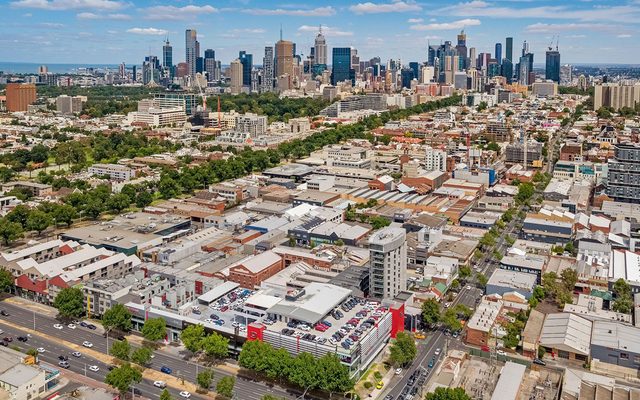This article is from the Australian Property Journal archive
THE national housing crisis has taken centre stage of the federal budget, with the Albanese government promising to boost supply, student accommodation and lift Commonwealth Rent Assistance again, while slashing immigration from its record highs.
Treasurer Jim Chalmers’ budget has been handed down at a time of record low vacancies amid a crushing mismatch between supply and demand, exacerbated by record population growth. The result has been rents jacked up at their fastest rate in 17 years, and a housing market plagued by affordability issues.
The government had already touted $11.3 billion worth of housing initiatives ahead of last night, including $9.3 billion over the next five years to combat homelessness, provide crisis support and build and repair social housing.
“We’re addressing the pressures caused by population growth, with net overseas migration next year now expected to be half what it was last year,” Chalmers said in his budget speech last night. The government said it would slash the net overseas migration intake of 528,000 in 2022-23 to 395,000 this year, and then to 260,000 in 2024-25.
A key driver of the population growth, international students, will be reined in and a new formula introduced that will place a cap on how international enrolments each university can take.
Chalmers said Australia’s international education sector is a “national asset”, “but for too long, enrolments have grown without being matched by an increase in student housing supply”.
“This puts pressure on prices and rents, especially in our cities and suburbs.
“We will limit how many international students can be enrolled by each university based on a formula, including how much housing they build.”
The number of international students in Australia surged by 15% to 671,000 in the year to the end of March.
“Australia’s growing international education sector requires adequate supply of purpose-built student accommodation to ensure its ongoing sustainability,” the budget papers said.
“To deliver more accommodation for students and to reduce pressure on the private rental market, the government will work with the higher education sector to develop regulations that will require universities to increase their supply of student accommodation.”
Student Accommodation Council executive director Torie Brown wrote in a new report last week that, “International students have been unfairly blamed for the rental crisis…long-term structural issues in Australia’s housing market are the real cause for rental pressures.”
The report shows the current pipeline of new purpose-built student accommodation (PBSA) tallies 7,770 new beds due to come online by 2026, and is not enough to alleviate demand in the private rental market.
The report finds that in order to reduce the impact of international students on the rental market, the future supply pipeline of PBSA will need to be increased to 84,000 new beds by 2026.
Commonwealth Rent Assistance boosted again
The government will put $1.9 billion towards increasing the maximum rates of Commonwealth Rent Assistance by a further 10% in a bid to alleviate rental stress. This follows the 15% increase already made last September, taking the increase to Commonwealth Rent Assistance maximum rates to over 40% since May 2022, including indexation.
Nearly one million households – around one quarter of all renters – receive the maximum rate of Commonwealth Rent Assistance.
The increase marks the first back‑to‑back increase to Commonwealth Rent Assistance in more than 30 years.
The government also announced it is expanding the Affordable Housing Bond Aggregator by increasing Housing Australia’s liability cap to $10 billion from $5.5 billion.
The budget has been handed down on the eve of the government’s signature market, social and affordable housing supply boost initiatives.
Headlining those is the National Housing Accord, which aims to boost supply through the delivery of 1.2 million “well-located” homes across the country.
The government said accelerating new supply will help to lower prices and ease affordability pressures, which is supported by empirical research which shows that OECD countries that built more housing between 1990 to 2015 experienced lower growth in real house prices.
Research found adding an extra 50,000 homes a year for a decade could reduce house prices up to 20% and a 1% increase in the stock of dwellings could lower house prices by 2.5%.
The government admits that housing affordability challenges have productivity, health and social inclusion implications, and a lack of investment in housing – both public and private – can result in a housing system that entrenches adverse health and socio-economic outcomes. This is especially pronounced for children vulnerable to socioeconomic inequality, living in disadvantaged neighbourhoods or being unable to rely on intergenerational wealth transfers. Quality housing improves children’s development and wellbeing, and can lead to better education outcomes, particularly for those with intergenerational disadvantage. An undersupplied and underinvested housing system creates more instances of overcrowded and poor-quality dwellings, which Brackertz et al. (2019) identifies as increasing the likelihood of developing chronic physical and mental health conditions, and increasing the risk of domestic and family violence.
“Our goal is ambitious – but achievable, if we all work together and if we all do our bit,” Chalmers said in his budget speech.
However, the National Housing Accord target is considered farfetched by analysts amid severe labour shortages, as well as current low approval rates and planning red tape. A new landmark broad-ranging report, State of the Housing System, tabled by the Albanese government’s National Housing Supply and Affordability Council, said Australia will miss the National Housing Accord target on current market, industry and economic trajectories.
Capital Economics has in the past week said the downturn in home building has “much further to run”, which is set to worsen the shortage of rentals.
The government has already announced a $91 million investment to increase the building and construction workforce numbers that fall under the coming year’s budget.
Running concurrently with the National Housing Accord is the $10 billion Housing Australia Future Fund that will aim to deliver 20,000 new social and 10,000 new affordable homes, while the National Housing Accord Facility aims to deliver a further 10,000 affordable homes.
The $2 billion Social Housing Accelerator is already up and running and will fund 4,000 new and refurbished social homes.
“Australia’s housing system has been too slow to respond to demand. The causes of this are multifaceted, complex and affect all stages of the housing construction process, including all levels of government and industry,” the budget papers said.
“Planning and zoning and land release practices are often slow and are not effectively factoring in urgent need for housing in suburban areas. Industry’s capacity to add new supply has been hampered by a lack of essential infrastructure in greenfield developments, a critical shortage of skilled labour and falling productivity in the sector.
“At the same time, there has been a long‑term, chronic under‑investment in social housing.”




